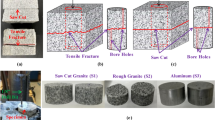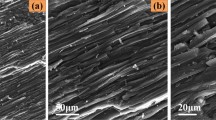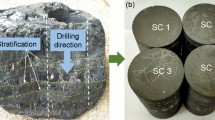Abstract
The geochemical and geomechanical behaviour of reservoir rocks from deep saline aquifers during the injection and geological storage of CO2 is studied in laboratory experiments. A combination of geochemical and geomechanical studies was carried out on various sandstones from the North German Basin. After the mineralogical, geochemical and petrophysical characterization, a set of sandstone samples was exposed to supercritical (sc)CO2 and brine for 2–4 weeks in an autoclave system. One sample was mineralogically and geochemically characterised and then loaded in a triaxial cell under in situ pressure and temperature conditions to study the changes of the geomechanical rock properties. After treatment in the autoclaves, geochemical alterations mainly in the carbonate, but also in the sheet silicate cements as well as in single minerals of the sandstones were observed, affecting the rocks granular structure. In addition to partial solution effects during the geochemical experiments, small grains of secondary carbonate and other mineral precipitations were observed within the pore space of the treated sandstones. Results of additional geomechanical experiments with untreated samples show that the rock strength is influenced by the saturation degree, the confining pressure, the pore fluid pressure and temperature. The exposure to pure scCO2 in the autoclave system induces reduced strength parameters, modified elastic deformation behaviour and changes of the effective porosity in comparison to untreated sandstone samples. Experimental results show that the volume of pore fluid fluxing into the pore space of the sandstones clearly depends on the saturation level of the sample.









Similar content being viewed by others
References
Alemu BL, Aker E, Soldal M, Johnsen Ø, Aagaard P (2012) Effect of sub-core scale heterogeneities on acoustic and electrical properties of a reservoir rock: a CO2 flooding experiment of brine saturated sandstone in a computed tomography scanner. Geophys Prospect. doi:10.111/j.1365-2478.2012.01061.x
Anderson OL, Grew PC (1977) Stress corrosion theory of crack propagation with application to geophysics. Rev Geophys Space Phys 15:77–104
Andre′ L, Audigane P, Azaroual M, Menjoz A (2007) Numerical modelling of fluid–rock chemical interactions at the supercritical CO2–liquid interface during supercritical CO2 injection into a carbonate reservoir, the Dogger aquifer (Paris Basin, France). Energy Convers Manage 48:1782–1797
Azaroual M, Pruess K, Fouillac C (2007) Feasibility of using supercritical CO2 as heat transmission fluid in the EGS (Enhanced Geothermal Systems) integrating the carbon storage constraints. ENGINE—Enhanced Geothermal Innovative Network for Europe. Workshop 2, Volterra Italy
Bachmann GH, Voigt T, Bayer U, von Eynatten H, Legler B, Littke R (2008) Depositional history and sedimentary cycles in the Central European Basin System. In: Littke R, Bayer U, Chajewski D, Nelskamp S (eds) Dynamics of Complex Intracontinental Basins. The example of the Central European Basin System. Springer, Heidelberg, pp 157–172
Baker JC, Bai GP, Hamilton PJ, Golding SD, Keene JB (1995) Continental-scale magmatic carbon dioxide seepage recorded by dawsonite in the Bowen-Gunnedah-Sydney Basin system. Eastern Australia. J Sediment Res A65(3):522–530
Birkholzer JT, Zhou Q, Tsang C (2009) Large-scale impact of CO2-storage in deep saline aquifers: a sensitive study on pressure response in stratified systems. Int J Greenhouse Gas Control 3:181–194
Busenberg E, Clemency C (1976) The dissolution kinetics of feldspars at 25 °C and 1 atm CO2 partial pressure. Geochim Cosmochim Acta 40(1):41–49
Busenberg E, Plummer LN (1986) A comparative study of the dissolution and crystal growth kinetics of calcite and aragonite. In: Mumpton FA (ed) Studies in diagenesis. US Geological Survey Bulletin, vol 1578, pp 139–158
Ellis A (1959) The solubility of calcite in carbon dioxide solutions. Am J Sci 257:354–365
Fernandez-Carrasco L, Puertas F, Blanco-Varela MT, Vazquez T, Rius J (2005) Synthesis and crystal structure solution of potassium dawsonite: an intermediate compound in the alkaline hydrolysis of calcium aluminate cements. Cem Concr Res 35:641–646
Fischer C, Gaupp R, Dirnke M, Sill O (2007) A 3D High Resolution Model of Bounding Surfaces in Aeolian-Fluvial Deposits: an Outcrop Analogue Study from the Permian Rotliegend, Northern Germany. J Pet Geol 30(3):257–274
Fischer C, Dunkl I, von Eynatten H, Wijbrans JR, Gaupp R (2012) Products and timing of diagenetic processes in Upper Rotliegend sandstones from Bebertal (North German Basin, Parchim Formation, Flechtingen High, Germany). Geol Mag. doi: 10.1017/S0016756811001087
Förster A, Norden B, Zinck-Jorgensen K, Frykmann P, Kulenkampff J, Spangenberg E, Erzinger J, Zimmer M, Kopp J, Borm G, Juhlin C.-G, Cosma C, Harter S (2006) Boreline characterization of the CO2 SINK geological storage site at Ketzin, Germany. Environmental Geosciences 133:145–161
Gao Y, Liu L, Hu W (2009) Petrology and isotopic geochemistry of dawsonite-bearing sandstones in Hailaer basin, northeastern China. Appl Geochem 24(9):1724–1738
Gast R, Dusar M, Breitkreuz C, Gaupp R, Schneider JW, Stemmerik L, Geluk M, Geissler M, Kiersnowski H, Glennie K, Kabel S, Jones N (2010) Rotliegend. In: Doornenbal JC, Stevenson AG (eds) Petroleum geological atlas of the Southern Permian Basin Area. EAGE Publications, Houten
Gaus I, Audigane P, André L, Lions J, Jacquemet N, Durst P, Czernichowski-Lauriol I, Azaroual M (2008) Geochemical and solute transport modelling for CO2 storage, what to expect from it? Intern J Greenhouse Gas Control 2:605–625
Gemmer L, Nielsen SB, Bayer U (2003) Late Cretaceous-Cenozoic evolution of the North German Basin—results from the 3-D geodynamic modeling. Tectonophysics 373:39–54
Gerling JP, Reinhold K, Knopf S (2009) Speicherpotentiale für Deutschland. In: Die geologische Speicherung von CO2—Aktuelle Forschungsergebnisse und Perspektiven. Geotechnologien Science Report No. 14, 28–36
Gledhill DK, Morse JW (2006) Calcite solubility in Na-Ca-Mg-Cl brines. Chem Geol 233(3–4):249–256
Golab AN, Carr PF, Palamara DR (2006) Influence of localised igneous activity on cleat dawsonite formation in Late Permian coal measures, Upper Hunter Valley, Australia. Int J Coal Geol 66:296–304
Heinzelmann W (1969) Der Untere und der Mittlere Buntsandstein auf Blatt Nebra. Hall. Jb. Mitteldt. Erdgesch. 9:132–160
Hellevang H, Aagaard P, Oelkers EH, Kvamme B (2005) Can dawsonite permanently trap CO2? Environ Sci Technol 39:8281–8287
Hellevang H, Declercq J, Aagaard P (2011) Why is dawsonite absent in CO2 charged reservoirs? Oil and Gas Science and Technology—Rev. IFP Energies nouvelles 66(1):119–135
Hickman S, Sibson R, Bruhn R (1995) Introduction of special section: mechanical involvement of fluid in faulting. USGS Staff Published Research, Paper 410
Holdren GR Jr, Berner RA (1979) Mechanism of feldspar weathering—I Experimental studies. Geochim Cosmochim Acta 43:1161–1171
Holl A, Althaus E, Lempp C, Natau O (1997) The petrophysical behaviour of crustal rocks under the influence of fluids. Tectonophysics 275:253–260
Jaeger CJ, Cook NGW, Zimmerman R (2007) Fundamentals of Rock Mechanics. Wiley-Blackwell. p 488
Kaszuba JP, Janecky (2003) CO2 reaction processes in a model brine aquifer at 200 C and 200 bars: implications for geologic sequestration of carbon. Appl Geochem 18:1065–1080
Kulke H, Gast R, Helmuth H, Lützner H (1993) Harz Area, Germany: typical Rotliegend and Zechstein reservoirs in the Southern Permian basin (Central Europe. In: Mulock-Houwer JA, Pilaar WF, Graaff-Trouwborst VD (eds) Field Trip 4. AAPG International Conference and Exhibition, The Hague
Kummerow J, Spangenberg E (2011) Experimental evaluation of the impact of the interactions of CO2–SO2, brine and reservoir rock on petrophysical properties: a case study from the Ketzin test site. Germany. Geochem Geophys Geosyst 12(5):10. doi:10.1029/2010GC003469
Littke R, Bayer U, Gajewski D (2005) Dynamics of sedimentary basins: the example of the Central European Basin System. Int J Earth Sci 94:779–781
Lombard JM, Azaroual M, Pironon J, Broseta D, Egermann P, Murnier G, Mouronval G (2010) CO2 injectivity in geological storages: an overview of program and results of the geocarbon-injectivity project. Oil and gas science and technology—Rev. IFP 65(4):533–539
Main IG, Sammonds PR, Meredith PG (1993) Application of a modified Griffith criterion to the evolution of fractal damage during compressional rock failure. Geophys J Int 115:367–380
Marini L (2007) Geological sequestration of Carbon Dioxide—Thermodynamics, Kinetics, and Reaction Path Modelling. Developments in Geochemistry 11, p 453
May F, Müller C, Bernstone C (2005) How much CO2 can be stored in Deep Saline Aquifers in Germany? VGB PowerTech 6:32–37
Maystrenko Y, Bayer U, Brink HJ, Littke R (2008) The Central European Basin System—an overview. In: Littke R, Bayer U, Chajewski D, Nelskamp S (eds) Dynamics of Complex Intracontinental Basins. The example of the Central European Basin System, Springer, pp 17–34
Müller C (2009) Charakterisierung des hydromechanischen Verhaltens der Gesteine des Mittleren Buntsandsteins im Hinblick auf geothermische Nutzung: Strukturgeologische Geländeaufnahmen, gesteinsmechanische Untersuchungen und numerische Modellierungen. Georg-August-Universität Göttingen, Diss 2009
Otto V (2003) Inversion-related features along the southeastern margin of the North German Basin (Elbe Fault System). Tectonophysics 373:107–123
Plein E (1995) Stratigraphie von Deutschland, Norddeutsches Rotliegendbecken. Rotliegend Monographie Teil II. Courier Forschungsinstitut Senckenberg 183:1–193
Pudlo D, Albrecht D, Ganzer L, Gaupp R, Kohlhepp B, Meyer R, Reitenbach V, Wienand J (2011) Petrophysical, Facies and Mineralogical-Geochemical Investigations of Rotliegend Sandstones from the Altmark Natural Gas Field in Central Germany. Energy Proc 4:4648–4655
Radzinski, K.-H. (1966) Stratigraphische und paläontologische Untersuchungen im Unteren und Mittleren Buntsandstein des südöstlichen Harzvorlandes. Diss. Univ. Greifswald, 1966
Radzinski KH (1995) Zum Unteren und Mittleren Buntsandstein im Unstruttal bei Nebra (Südwestrand der Querfurter Mulde). Mitt Geol Sachsen Anhalt 1:85–103
Rettig B (1995) Die Solling-Folge (Mittlerer Buntsandstein) im Grenzgebiet zwischen Niedersachsen-Thüringen-Hessen. Mittteilungen des Geol. Inst. der Univ. Hannover 1995, 107 Seiten
Röhling HG (2008) Au(f)s diesem Fels müsst ihr bauen! Zur geologischen Einordnung der Burg Hanstein. In: Hans Dieter von Lanstein (Hsg). Burg Hanstein: Zur 700-jährigen Geschichte einer eichsfeldischen Grenzfeste. Mecke Druck und Verlag. Duderstadt 2008
Rutqvist J, Birkholzer JT, Cappa F, Tsang C-F (2007) Estimating maximum sustainable injection pressure during geological sequestration of CO2 using coupled fluid flow and geomechanical fault-slip analysis. Energy Convers Manage 48:1798–1807
Rutqvist J, Vasco DW, Myer L (2010) Coupled reservoir-geomechanical analysis of CO2 injection and ground deformations at In Salah, Algeria. Int J Greenhouse Gas Contr 4(2):225–230
Schütt H, Wigand M, Spangenberg E (2005) Geophysical and geochemical effects of supercritical CO2 on sandstones. In: Thomas DC, Benson S (eds) Carbon Dioxide Capture for Storage in Deep Geologic Formations—Results From the CO2 Capture Project, vol 2, pp 767–786, doi:10.1016/B978-008044570-0/50133-1
Sibson RH, Rowland JV (2003) Stress, fluid pressure and structural permeability in seismogenetic crust, North Island, New Zealand. Geophy J Int 154:584–594
Sorai M, Sasaki M (2010) Dissolution kinetics of anorthite in a supercritical CO2-water system. Am Mineral 95:853–862
Streit JE, Hillis RR (2004) Estimating fault stabilityand sustainable fluid pressure for underground storage of CO2 in porous rock. Energy 29:1445–1456
Vilarrasa V, Olivella S, Carrera J (2011) Geomechanical stability of the caprock during CO2 sequestration in deep saline aquifers. Energy Proc 4:5306–5313
Waza T, Kurita K, Mizutani H (1979) The effect of water on the subcritical crack growth in silicate rocks. Tectonophysics 67:25–34
Wibberley CAJ, Shimamoto T (2005) Earthquake slip weakening and asperities explained by thermal pressurization. Nature 436:689–692. doi:10.1038/nature03901
Wigand M, Carey JW, Schütt H, Spangenberg E, Erzinger J (2008) Geochemical effects of CO2 geochemistry in sandstones under simulated in situ conditions of deep saline aquifers. Appl Geochem 23:2735–2745
Zemke K, Liebscher A, Wandrey M, The CO2SINKGroup (2010) Petrophysical analysis to investigate the effects of carbon dioxide storage in a subsurface saline aquifer at Ketzin, Germany (CO2SINK). Int J Greenhouse Gas Contr 4:990–999
Acknowledgments
The work was carried out within the German national project COORAL (“CO2 Purity for Capture and Storage”), which is financially supported by the Federal Ministry of Economics and Technology. Third party funding was provided by ALSTOM, EnBW, E.ON, Vattenfall, and VNG. The authors gratefully acknowledge the technicians of the Martin-Luther-University Halle-Wittenberg who executed all geomechanical tests as well as the geochemical analytical work. The authors would like to thank Mr. D. Erickson for revising the English language of the text. We appreciated the comments of the anonymous reviewers.
Author information
Authors and Affiliations
Corresponding authors
Rights and permissions
About this article
Cite this article
Marbler, H., Erickson, K.P., Schmidt, M. et al. Geomechanical and geochemical effects on sandstones caused by the reaction with supercritical CO2: an experimental approach to in situ conditions in deep geological reservoirs. Environ Earth Sci 69, 1981–1998 (2013). https://doi.org/10.1007/s12665-012-2033-0
Received:
Accepted:
Published:
Issue Date:
DOI: https://doi.org/10.1007/s12665-012-2033-0




